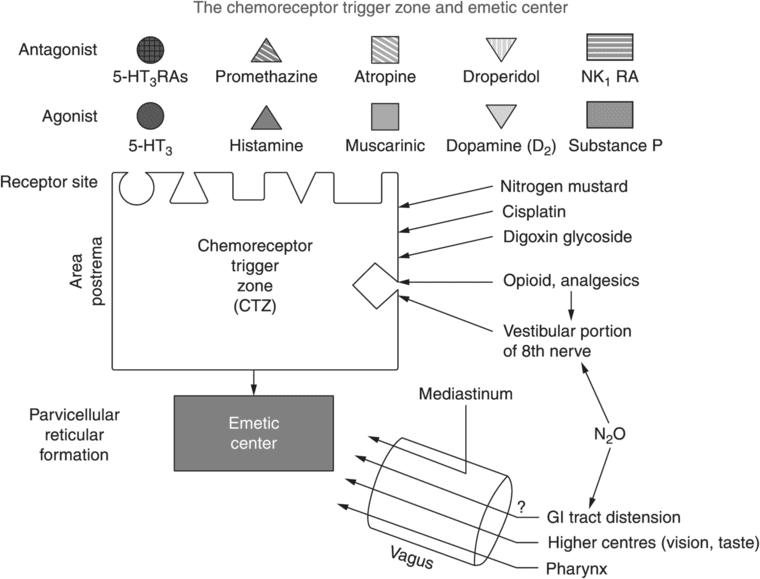| Risk factors for PONV in adults | |
|---|---|
| Positive evidence | Female sex |
| History of PONV or motion sickness | |
| Non-smoking | |
| Younger age | |
| Use of volatile agents | |
| Postoperative opioids | |
| Duration of anesthesia | |
| Type of surgery | |
| Conflicting evidence | ASA physical status |
| Menstrual cycle | |
| Level of anesthetist’s experience | |
| Neuromuscular blockade antagonism | |
ASA, American Society of Anesthesiologists
The accurate assessment of risk is important, since prophylaxis is only warranted for high-risk patients.[5] Prophylaxis of low-risk patients increases costs and the incidence of side effects without improving outcomes and is not recommended by most organizations offering guidelines. However, many patients who warrant prophylaxis do not receive therapy consistent with current recommendations.[6]
It is important that the above-mentioned factors be considered when treating PONV. The incidence of PONV may be affected by targeting a number of different receptors within the central nervous system. High-risk patients may receive two or three anti-emetic therapies as prophylaxis prior to arrival in the Post-Anesthesia Care Unit (PACU). If prophylaxis has failed, it is important to establish which receptors have been already targeted so that therapy can be directed towards different receptors. Avoiding redundant therapy avoids unnecessary dose-related medication side effects.
Physiology
Emesis is a coordinated reflex in which gastric contents are forcibly expelled while the airway is protected and must be distinguished from the passive reflux of gastric contents in the presence of an unprotected airway. These separate processes are frequently confused, and the distinction between them has important implications for treatment. Whereas the treatment of passive reflux is aimed at limiting the sequela of pulmonary aspiration by increasing pH or decreasing volume, treatment of PONV is directed at preventing the initiation of the emesis reflex.
The chemoreceptor trigger zone (CTZ) is an area of the medulla which communicates with the emesis center in the area postrema via the nucleus tractus solitarius (NTS). The CTZ has an incomplete blood–brain barrier, so emetogenic chemicals in the blood may stimulate emesis. Additionally, the CTZ receives rich input from the middle ear, so the CTZ has a central role in emesis from motion sickness as well. A variety of neurotransmitters and receptors including acetylcholine, dopamine, histamine (H1 receptor), substance P (NK1 receptor), and serotonin (5-HT3 receptor) are found in the CTZ, so an assortment of medications may reduce the incidence of PONV[12] (see Figure 19.2). Most pharmacological prophylaxis or treatment for PONV is directed at stabilizing the CTS, NTS, or both.
Although the emesis center is primarily involved in the motor function of emesis, it is important to note that emesis may be initiated by direct vagal afferents on the emesis center. A number of gastric or bowel irritants may directly initiate emesis without the involvement of the CTZ, and conventional therapy directed at CTZ receptor blockade will have limited efficacy in such cases. In the postoperative setting, this is primarily due to the irritating effect of swallowed blood on the stomach. Procedures in which blood is swallowed, including tonsillectomy, dental extractions, other surgeries within the mouth, and sinus surgery, may require unique therapy for PONV.
PONV management
Low-dose administration of medications from different classes is better than administration of higher doses of a single medication. Escalating the dose of a single agent often increases side effects significantly more than efficacy. Repeating a dose of a previously administered anti-emetic is rarely appropriate in the early postoperative period.[4]
In choosing an anti-emetic, consider mechanism of action, previously administered medications, patient allergies, and speed of onset. Some medications used for prophylaxis are inappropriate for rescue therapy owing to slow onset. Medications efficacious in the rescue therapy of PONV are presented in Table 19.2.
| Medication class | Examples | Comments |
|---|---|---|
| Corticosteroids | Dexamethasone 5–10 mg | Not indicated for rescue therapy |
| 5-HT3 receptor antagonists | Ondansetron 1 mg IV | Lower dose for rescue therapy than for prophylaxis |
| Dolasetron 12.5, 25, 50, or 100 mg IV | No longer available in the USA, demonstrated efficacy for rescue therapy, little benefit from dose escalation | |
| Granisetron 2–20 mcg/kg | Less QT prolongation than ondansetron | |
| Tropisetron 0.5, 2 or 5 mg IV | Not available in the USA, demonstrated efficacy for rescue therapy, little benefit from dose escalation | |
| Ramosetron 0.3 mg IV | Not available in the USA | |
| Palonosetron 0.75 mg IV | Second generation, FDA approved for prophylaxis only | |
Antidopaminergics Stay updated, free articles. Join our Telegram channel
Full access? Get Clinical Tree


|


